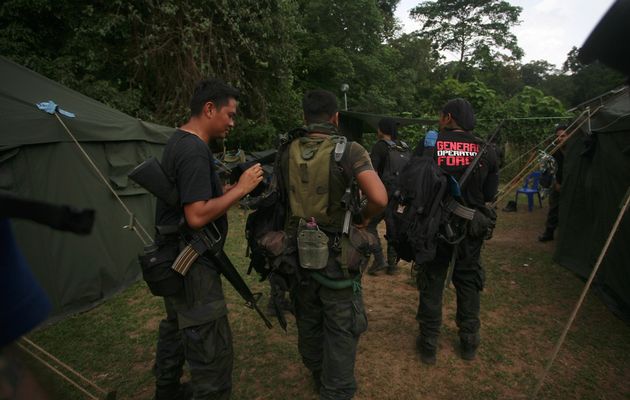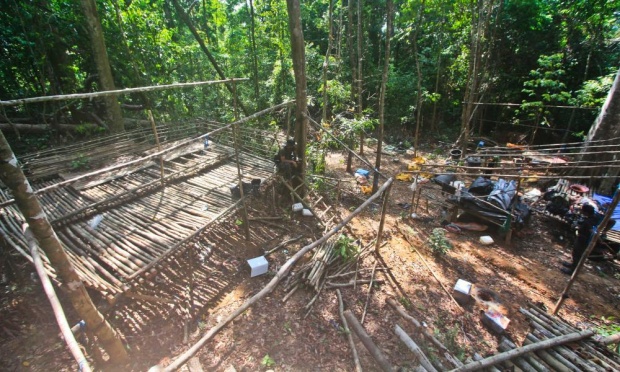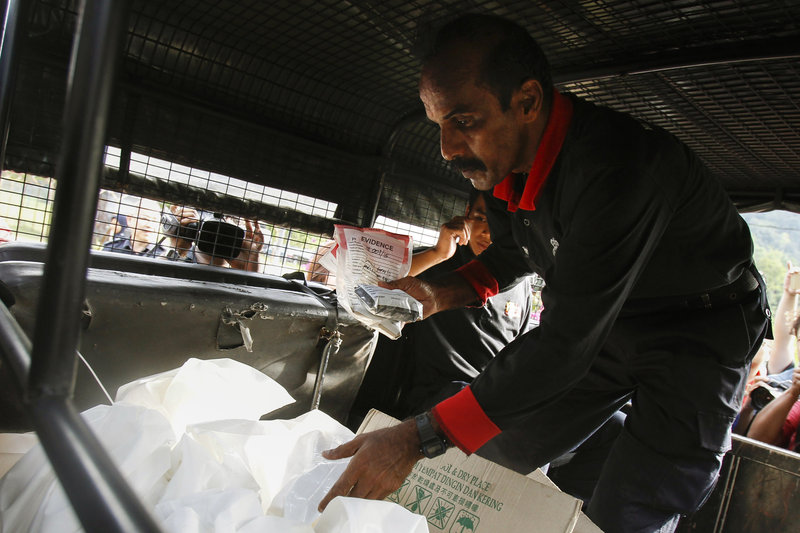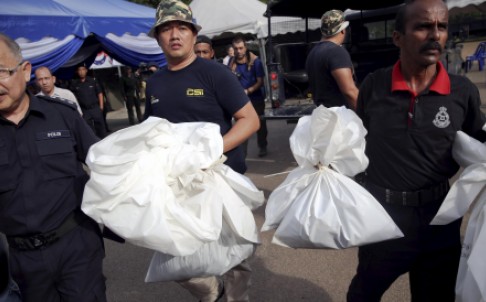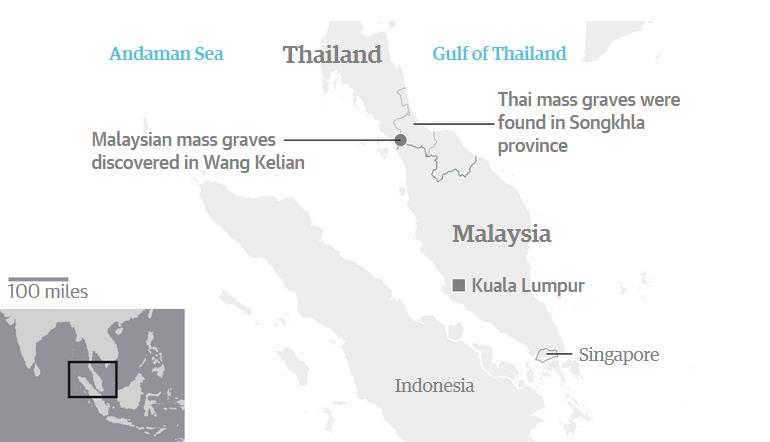The Story Behind The 139 Mass Graves Reveal The Grim Reality Of Human-Trafficking
"I am shocked. We never expected this kind of cruelty," Khalid told reporters at a police outpost in the town of Wang Kelian several kilometers from the camps, one of which appeared large enough to hold about 300 people.
In an operation that began on 11 May, Malaysian police have found 139 graves strewn across the Perlis range of hills that rise from Malaysia into Thailand, in the vicinity of 28 abandoned camps, the IGP, Khalid Abu Bakar, confirmed on 25 May, Times LIVE reported
Malaysian Police officers are seen inside the camp after bringing down the human remains from the mass grave site of ethnic Rohingyas between the Malaysia-Thailand borders in Wang Kelian in state of Perlis on May 25, 2015 outside Kuala Lumpur Malaysia.
Image via Mohd Samsul Mohd Said/Getty ImageSpeaking with reporters in the northern state of Perlis, Khalid said:
"It's a very sad scene... To us even one is serious and we have found 139. We are working closely with our counterparts in Thailand. We will find the people who did this."
"We were shocked by the cruelty," said Khalid, describing conditions at the 28 abandoned camps, scattered along a 50 km (30 mile) stretch of the Thai border, around which the graves were found in an operation that began on May 11.
Khalid said bullet casings were found in the vicinity and added there were signs that torture had been used, without elaborating. Metal chains were found near some graves.
The investigators searching the dense jungle not only found crudely erected barbed-wire pens and wooden cages, they also discovered a teddy bear and small-sized sandals, a sign that children were held in the camps, according to this NPR report. The grisly find follows the discovery of similar shallow graves on the Thai side of the border earlier this month, which helped trigger a regional crisis.
An abandoned human trafficking camp. Graves were found nearby, close to the border with Thailand at Wang Kelian, Malaysia.
Image via Royal Malaysian police/EPAThe first mass graves of migrants were discovered earlier this month in southern Thailand. Rohingya migrants Burma typically travel by boat to Thailand, hoping to make their way to Malaysia, which is more tolerant of the Muslim refugees.
Autopsies conducted on those remains indicate the victims had starved to death or had died of disease. Investigators say the graves likely contain the remains of Burmese fleeing harsh conditions in Myanmar.
A Malaysian forensic team personnel handles bags of human remains found at abandoned camps used by human traffickers on the Malaysia-Thailand border in Wang Kelian on Monday.
Image via Joshua Paul/APPolice also discovered ammunition, suggesting that the gangs were armed. Meanwhile, according to an Irish Times report, 25 May, it took hours to bring the first decomposed body down to a police camp at the base of the mountains where the camps were found.
“The body was only bones and little bit of clothing on it,” Rizani Che Ismail, officer in charge of Padang Besar police department, told Reuters, adding that the cause of death was not immediately apparent.
How many bodies each grave contains is not yet clear, nor is it known how the people may have died. But these remains are believed to be a grim by-product of the human-trafficking trade that for years has transported persecuted Rohingya Muslims from Burma, as well as, increasingly, Bangladeshis desperate to escape
An abandoned camp allegedly for trafficked Rohingya and Bangladeshis in mountainous jungle on the Malaysian side of the Thai-Malaysian border.
Image via James Nachtwey/TIME"Some of the camps found showed that they have been occupied since 2013, and the latest two camps were abandoned two to three weeks ago," Khalid told Bernama, the Malaysian state news agency.
"The police are unable to confirm whether all the graves contain human remains as the digs have not ended as yet," he said. He added that the bodies will be sent for post-mortem analysis to determine the causes of death before they are buried.
Officials carry bags with human remains found at the site of trafficking camps. The number and size of the camps suggest they may have been capable of housing hundreds of people. Khalid said the largest could hold up to 300 people; another had a capacity of 100, and the rest could hold about 20 each, SCMP reported.
The scale of the camp discoveries has raised questions about the level of complicity by officials on both sides of the border. Malaysia's Home Minister Ahmad Zahid Hamidi said on Tuesday that initial investigations revealed links between forest rangers and smuggling syndicates, Bernama reported, adding that some had been detained by police as part of the probe.
"We suspect some of them were involved...but we are working with the forestry department in terms of enforcement as they are supposed to carry out enforcement in the area," he was quoted as telling reporters at parliament.
Apparently abandoned in haste, what remained of the camp visited by Reuters reporters was little more than a tangle of bamboo and tarpaulin, but one police official, who did not want to be identified, said it could have held up to 400 people.
A large plastic water tank could be seen, suggesting a degree of permanence.
A 2009 report for the Committee on Foreign Relations of the United States Senate alleged that Malaysian officials worked in conjunction with human traffickers
"Burmese migrants in Malaysia, often regardless of whether they possess UNHCR identification, are arrested and placed in detention facilities," it said. "The committee has reports of individual refugees UNHCR official documentation being destroyed by Malaysian officials at the time of arrest or later."
Testimony given to researchers for the committee gave an insight into how the people smuggling camps operated. Migrants from Burma told the committee they were "transported to the border by Malaysian Government officials using Malaysian Immigration Department vehicles.
Arriving at the border between 1:00 and 3:00 am, they were handed over to human traffickers, operating from the Thai side of the border." They were then kept in captivity and often beaten and sexually abused. "The traffickers would then allow the refugees opportunity to contact someone in Malaysia who could pay a ransom of 1500-1900 ringgit [Malaysian currency] ($470 to $600), per person. Those able to pay were smuggled back into Malaysia and released," it said.
While the report concluded that migrants who could not raise the ransom money were sold into slavery, either to fishing boats or brothels, the discovery of mass graves indicates that many do not make it out of the camps at all.
Prime Minister Najib Razak vowed to find the perpetrators
"I am deeply concerned with graves found on Malaysian soil purportedly connected to people smuggling. We will find those responsible," he said on Twitter early Monday.
Meanwhile, on 26 May, Malaysian police forensic teams began the grim task of exhuming the bodies, which, according to the IGP, Khalid Abu Bakar, is going to be a long and tedious process
"It is about a three-hour hike to some of these camps and then the remains must be brought down through the difficult terrain.
We are handling this respectfully and humanely while working so as to not destroy any evidence," Khalid said, while he was speaking at a press conference at the Wang Kelian General Operations Force tactical base yesterday.
